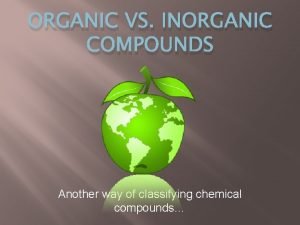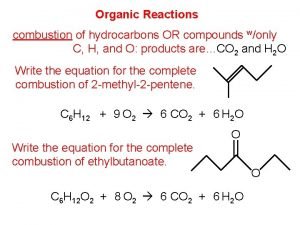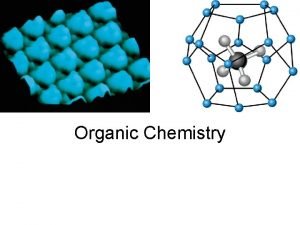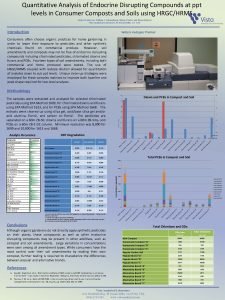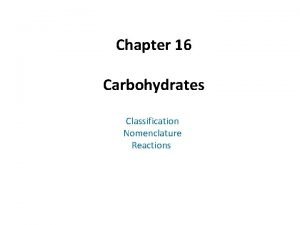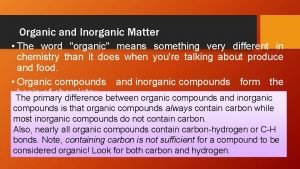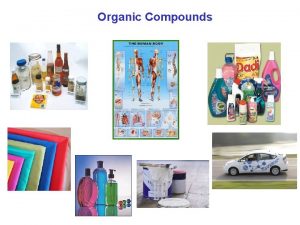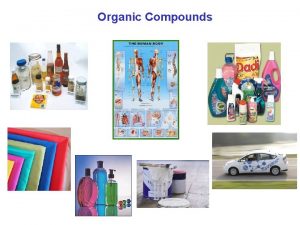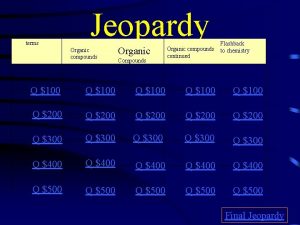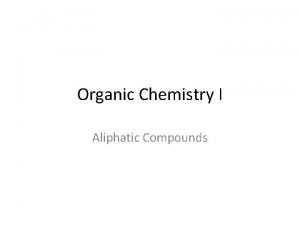ORGANIC CHEMISTRY 5 3 ORGANIC COMPOUNDS Organic compounds










- Slides: 10

ORGANIC CHEMISTRY 5. 3

ORGANIC COMPOUNDS Organic compounds contains carbon and usually hydrogen “Organic” sounds like the compounds come from living things, but some do and some don’t. Inorganic compounds are compounds that do not have carbon (as well as some exceptions: CO 2, CO, and ionic carbonates


WHY CARBON? It has four electrons in its valence shell, which allows for more chemical bonding possibilities than any other element Long chains of carbon have the possibility of forming E. g. petroleum and plastics

HYDROCARBONS pentane (C 5 H 12) organic compounds that contain only carbon and All hydrocarbons are hydrogen. flammable, and most are Hydrocarbons are based on liquids at room temperature a carbon “backbone”, or chain, with hydrogen atoms added on the sides. The simplest hydrocarbon is methane (CH 4), followed by ethane (C 2 H 6), propane (C 3 H 8), butane (C 4 H 10), and

IN GENERAL, THIS IS HOW WE NAME HC’S # of carbon atoms Prefix Hydrocarbon 1 Meth- Methane 2 Eth- Ethane 3 Prop- Propane 4 But- Butane 5 Pent- Pentane

ALCOHOLS are organic compounds with an -OH group off of the carbon chain. The simplest alcohols are methanol (CH 3 OH), ethanol (C 2 H 5 OH) and isopropyl alcohol (C 3 H 7 OH). Alcohols are very good solvents (they dissolve other substances) Alcohols are generally very flammable You can remember by looking at the name: al. COHol.

ALCOHOLS END IN -OL

BALL-AND-STICK P. 249 Once you’ve made one, draw it on the whiteboard. One partner builds, one partner draws. Then switch.

HOMEWORK Do Recognizing organic and inorganic compounds in Workbook (somewhere around p. 85) Do Checking Your Understanding (p 251) #3, 4 (a, c, e, g, i), 6, 7, 10 (a, c), 11 (all)
 Functional groups priority
Functional groups priority Organic vs inorganic chemistry
Organic vs inorganic chemistry Ib organic chemistry functional groups
Ib organic chemistry functional groups Venn diagram ionic and covalent bonds
Venn diagram ionic and covalent bonds Organic vs inorganic compounds
Organic vs inorganic compounds Organic combustion
Organic combustion Classification of hydrocarbons
Classification of hydrocarbons Quantitative analysis of organic compounds ppt
Quantitative analysis of organic compounds ppt Reactions of organic compounds
Reactions of organic compounds Importance of organic compounds
Importance of organic compounds What is inorganic matter
What is inorganic matter




